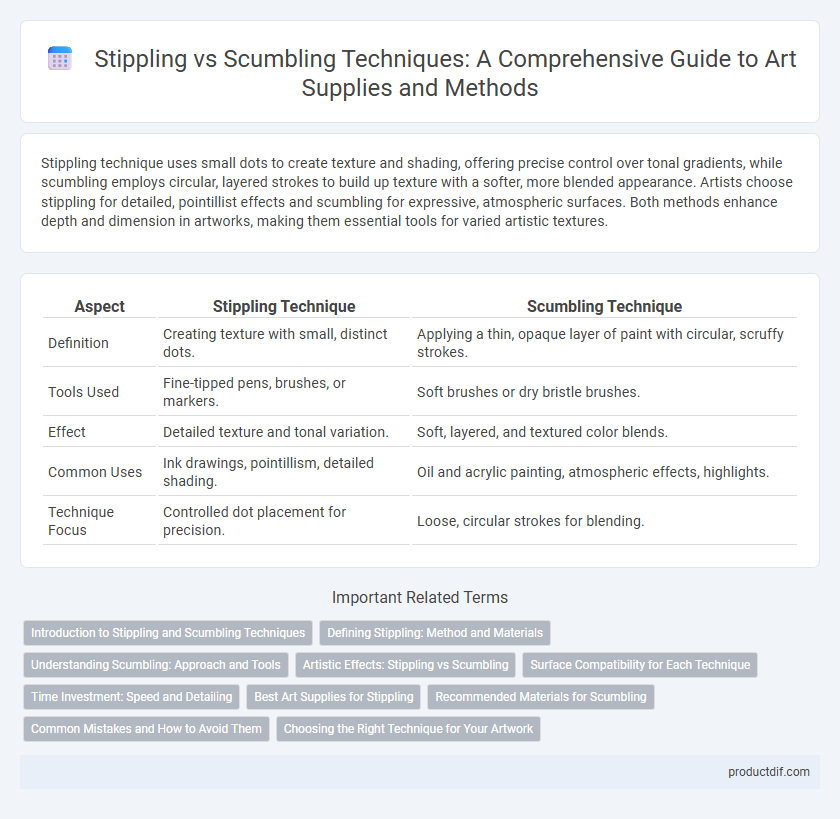Stippling technique uses small dots to create texture and shading, offering precise control over tonal gradients, while scumbling employs circular, layered strokes to build up texture with a softer, more blended appearance. Artists choose stippling for detailed, pointillist effects and scumbling for expressive, atmospheric surfaces. Both methods enhance depth and dimension in artworks, making them essential tools for varied artistic textures.
Table of Comparison
| Aspect | Stippling Technique | Scumbling Technique |
|---|---|---|
| Definition | Creating texture with small, distinct dots. | Applying a thin, opaque layer of paint with circular, scruffy strokes. |
| Tools Used | Fine-tipped pens, brushes, or markers. | Soft brushes or dry bristle brushes. |
| Effect | Detailed texture and tonal variation. | Soft, layered, and textured color blends. |
| Common Uses | Ink drawings, pointillism, detailed shading. | Oil and acrylic painting, atmospheric effects, highlights. |
| Technique Focus | Controlled dot placement for precision. | Loose, circular strokes for blending. |
Introduction to Stippling and Scumbling Techniques
Stippling technique involves creating images using small dots to build texture and depth, often applied with pens or brushes for precise detail in art supply projects. Scumbling technique uses a controlled, circular, or scribble-like motion to layer translucent marks, producing soft textures and tonal variations with dry brushes or pencils. Both techniques offer unique textural effects, essential for artists seeking to enhance dimension and visual interest in their artwork.
Defining Stippling: Method and Materials
Stippling is a painting and drawing technique involving the application of countless small dots or dashes to build texture, depth, and tone. Artists commonly use fine-tip pens, brushes, or pencils with inks, acrylics, watercolor, or graphite to achieve precise control over shading and detail. This method enhances visual interest by creating gradients and intricate patterns through varying dot density and placement.
Understanding Scumbling: Approach and Tools
Scumbling involves applying a thin, broken layer of paint or pastel over a dry base to create texture and tonal variation, often achieved with stiff brushes or dry, rounded tools for controlled, circular motions. This technique relies on light pressure and overlapping strokes to build soft transitions and depth without fully covering the underlying surface. Artists typically use scumbling to achieve subtle color blending and atmospheric effects that enhance visual richness in their work.
Artistic Effects: Stippling vs Scumbling
Stippling technique creates texture through numerous small dots, producing detailed shading and a pointillist effect ideal for intricate, controlled tonal variations. Scumbling technique uses light, circular, or scribbled strokes to build up layers of color and texture, resulting in a soft, atmospheric, and more expressive finish. Artists choose stippling for precision and clarity, while scumbling enhances depth and subtlety in brushwork.
Surface Compatibility for Each Technique
Stippling technique works best on smooth or lightly textured surfaces, such as Bristol board or hot-pressed watercolor paper, allowing precise dot application for detailed shading and texture. Scumbling technique thrives on rougher surfaces like cold-pressed watercolor paper or canvas, where its loose, circular strokes create rich, layered textures by catching the raised paper grain. Choosing the right surface enhances the effectiveness of each technique, maximizing their unique textural and tonal qualities in artwork.
Time Investment: Speed and Detailing
Stippling technique requires significant time investment due to meticulous placement of numerous individual dots, resulting in highly detailed textures and gradual tonal transitions. Scumbling technique allows for faster coverage with loose, circular strokes, creating a textured, layered effect but less precise detail compared to stippling. Artists often choose stippling for intricate, controlled shading and scumbling when speed and expressive texture are prioritized.
Best Art Supplies for Stippling
Stippling technique requires fine-tipped pens or brushes with consistent ink flow to achieve precise, controlled dots, making micron pens and sable hair brushes ideal choices. High-quality, acid-free paper with smooth texture enhances stippling detail and prevents bleeding, ensuring longevity of artwork. For scumbling, softer brushes with flexible bristles are preferred, but for stippling, the best art supplies emphasize precision and durability to maintain dot integrity.
Recommended Materials for Scumbling
For the scumbling technique, recommended materials include soft graphite pencils, charcoal sticks, and pastel crayons to achieve textured, layered effects. Use textured paper such as cold-pressed watercolor paper or rough sketch pads to enhance the grab of pigment and create depth. Blending tools like tortillons or stumps help control the application and smooth transitions in the scumbling process.
Common Mistakes and How to Avoid Them
Common mistakes in the stippling technique include applying uneven pressure that results in inconsistent dot sizes and crowding dots too closely, causing a muddy texture; to avoid this, artists should practice controlled, light touches and maintain even spacing. In scumbling, errors often arise from heavy hand pressure that blurs strokes and neglecting directional layering, which leads to a lack of depth; artists can prevent these by using a loose, circular motion with a light touch and building layers gradually. Mastering the subtleties of pressure control and stroke consistency in both techniques enhances texture realism and visual interest in art projects.
Choosing the Right Technique for Your Artwork
Choosing the right technique for your artwork depends on the desired texture and depth; stippling uses numerous small dots to create intricate shading and precise detail, ideal for realistic and controlled effects. Scumbling employs loose, circular strokes that build soft, layered textures, perfect for expressive and atmospheric compositions. Understanding the distinct visual outcomes of stippling and scumbling helps artists select the appropriate method to enhance their creative vision and achieve the intended mood.
Stippling Technique vs Scumbling Technique Infographic

 productdif.com
productdif.com